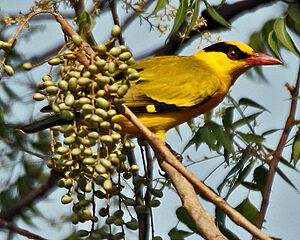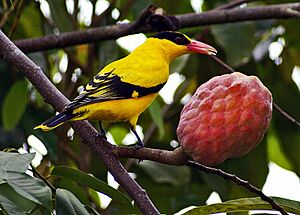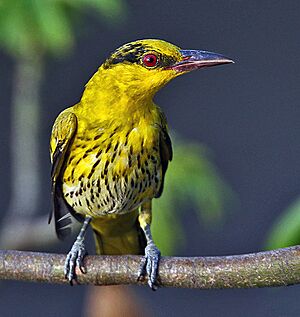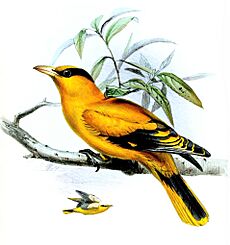Black-naped oriole facts for kids
The black-naped oriole (Oriolus chinensis) is a beautiful songbird that belongs to the oriole family. You can find these birds in many parts of Asia. They are known for their bright golden color.
One special thing about the black-naped oriole is its black stripe. This stripe goes across its eyes and joins at the back of its neck. This is different from the Indian golden oriole, which has a shorter stripe. Both male and female black-naped orioles look very similar. However, the female's wing lining is a bit more greenish. They have a strong, pink bill.
Quick facts for kids Black-naped oriole |
|
|---|---|
 |
|
| Adult female O. c. diffusus (Hyderabad, India) | |
| Conservation status | |
| Scientific classification | |
| Genus: |
Oriolus
|
| Species: |
chinensis
|
Contents
How Scientists Name and Group Them
Scientists give every living thing a special two-part name. This is called a binomial name. It helps everyone around the world know exactly which animal or plant they are talking about.
The black-naped oriole's scientific name is Oriolus chinensis. This name was given by a famous Swedish scientist named Carl Linnaeus in 1766. He called it "Chinese oriole" because he thought it came from China. Later, scientists found out it actually came from Manila in the Philippines.
Different Types of Black-naped Orioles
Just like people from different countries might look a little different, birds of the same species can also have slight differences depending on where they live. These different groups are called subspecies.
There are 20 known subspecies of the black-naped oriole. Each one lives in a specific area:
- O. c. diffusus: Found in eastern Siberia, China, Korea, and Japan.
- O. c. andamanensis: Lives on the Andaman Islands.
- O. c. macrourus: Found on the Nicobar Islands.
- O. c. maculatus: Lives in the Malay Peninsula, Sumatra, Java, and Borneo.
- O. c. mundus: Found on Simeulue and Nias Islands.
- O. c. sipora: Lives on Sipora Island.
- O. c. richmondi: Found on Siberut and Pagi Islands.
- O. c. lamprochryseus: Lives on Masalembu and Keramian Islands.
- O. c. insularis: Found on Sapudi, Raas, and Kangean Islands.
- O. c. melanisticus: Lives on Talaud Islands.
- O. c. sangirensis: Found on the Sangihe Islands.
- O. c. formosus: Lives on Siau and nearby islands.
- O. c. celebensis: Found on Sulawesi and nearby islands.
- O. c. frontalis: Lives on Banggai and Sula Islands.
- O. c. stresemanni: Found on Peleng Island.
- O. c. boneratensis: Lives on Bonerate, Djampea, and Kalao Islands.
- O. c. broderipi: Found on Lombok, Sumba, Sumbawa, Flores, and Alor Island.
- O. c. chinensis: Lives on Palawan, Luzon, and Mindoro in the Philippines.
- O. c. yamamurae: Found on the Visayan Islands, Mindanao, and Basilan in the Philippines.
- O. c. suluensis: Lives in the Sulu Archipelago in the Philippines.
What Do Black-naped Orioles Look Like?
The black-naped oriole is a medium-sized bird. It is mostly golden yellow with a bright pink bill. It has a wide black mask around its eyes and a black band on the back of its neck.
Adult males have central tail feathers tipped with yellow. The outer tail feathers are even more yellow. Females have a more greenish or olive color on their back. Young birds have streaks on their underside. Baby birds are dull greenish with brown streaks. Their head and neck are more yellowish.
Some subspecies have unique features. For example, the O. c. andamanensis from the Andamans has all black wings. The O. c. macrourus from the Nicobars has a very wide black band on its neck. This makes only the top of its head yellow.
The usual call of this bird sounds like a nasal "niee" or "myaa". Their song is a beautiful, fluty sound like "iwee wee wee-leeow". When they fly, they have a dipping motion.
Where Do Black-naped Orioles Live?
The diffusus subspecies breeds in eastern Siberia, China, Korea, and Japan. In winter, these birds fly to warmer places like India, Bangladesh, Thailand, and Myanmar.
The orioles living in the Andaman and Nicobar Islands stay there all year. In Singapore, these birds became common in city gardens around the 1920s. They were quite rare before that time.
Black-naped orioles like to live in forests, gardens, and plantations. They usually find their food, like berries and insects, high up in the trees.
Black-naped Oriole Life and Habits
Black-naped orioles eat many different kinds of berries. These include berries from Trema orientalis and Ficus trees. They also eat insects. Some scientists think these birds helped spread Ficus seeds to the island of Krakatoa. In India, they have been seen drinking nectar from large flowers. Sometimes, they might even eat the eggs or chicks of smaller birds.
Reproduction and Nests
The breeding season for black-naped orioles is usually from April to June. In the Nicobar Islands, it's from January to March. They build a deep, cup-shaped nest in the fork of a tree. The female lays two or three eggs. These eggs are salmon pink with reddish spots.
Orioles often build their nests near the nests of black drongos. This might be because drongos are very protective. The female oriole might build two or three nests before choosing one for her eggs. Sometimes, the male will sit near the unused nests.
Only the female bird sits on the eggs to keep them warm. The eggs hatch after about 14 to 16 days. The baby birds are ready to fly after another two weeks. The female stays close to the nest. She cleans it and chases away any animals that might harm her babies. The male bird helps more with feeding the young and guarding the nest.
Sometimes, other birds like Eurasian tree sparrows or black bulbuls use nests that the orioles have left behind. Animals like crows, treepies, and hawks sometimes try to eat the eggs or young birds. Sadly, in many parts of Southeast Asia, these beautiful birds are caught and sold in the bird trade.







